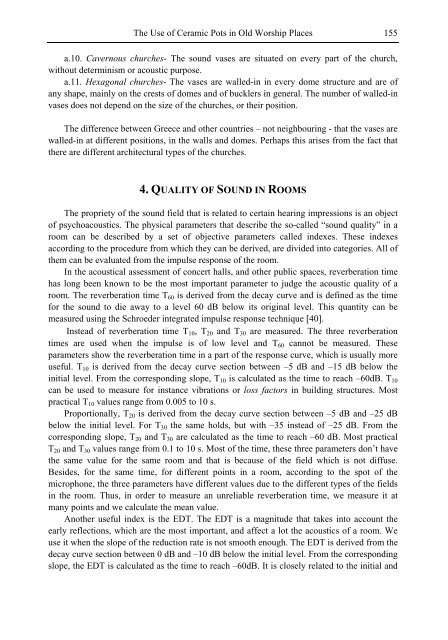Developments in Ceramic Materials Research
Developments in Ceramic Materials Research
Developments in Ceramic Materials Research
You also want an ePaper? Increase the reach of your titles
YUMPU automatically turns print PDFs into web optimized ePapers that Google loves.
The Use of <strong>Ceramic</strong> Pots <strong>in</strong> Old Worship Places 155<br />
a.10. Cavernous churches- The sound vases are situated on every part of the church,<br />
without determ<strong>in</strong>ism or acoustic purpose.<br />
a.11. Hexagonal churches- The vases are walled-<strong>in</strong> <strong>in</strong> every dome structure and are of<br />
any shape, ma<strong>in</strong>ly on the crests of domes and of bucklers <strong>in</strong> general. The number of walled-<strong>in</strong><br />
vases does not depend on the size of the churches, or their position.<br />
The difference between Greece and other countries – not neighbour<strong>in</strong>g - that the vases are<br />
walled-<strong>in</strong> at different positions, <strong>in</strong> the walls and domes. Perhaps this arises from the fact that<br />
there are different architectural types of the churches.<br />
4. QUALITY OF SOUND IN ROOMS<br />
The propriety of the sound field that is related to certa<strong>in</strong> hear<strong>in</strong>g impressions is an object<br />
of psychoacoustics. The physical parameters that describe the so-called “sound quality” <strong>in</strong> a<br />
room can be described by a set of objective parameters called <strong>in</strong>dexes. These <strong>in</strong>dexes<br />
accord<strong>in</strong>g to the procedure from which they can be derived, are divided <strong>in</strong>to categories. All of<br />
them can be evaluated from the impulse response of the room.<br />
In the acoustical assessment of concert halls, and other public spaces, reverberation time<br />
has long been known to be the most important parameter to judge the acoustic quality of a<br />
room. The reverberation time T60 is derived from the decay curve and is def<strong>in</strong>ed as the time<br />
for the sound to die away to a level 60 dB below its orig<strong>in</strong>al level. This quantity can be<br />
measured us<strong>in</strong>g the Schroeder <strong>in</strong>tegrated impulse response technique [40].<br />
Instead of reverberation time T10, T20 and T30 are measured. The three reverberation<br />
times are used when the impulse is of low level and T60 cannot be measured. These<br />
parameters show the reverberation time <strong>in</strong> a part of the response curve, which is usually more<br />
useful. T10 is derived from the decay curve section between –5 dB and –15 dB below the<br />
<strong>in</strong>itial level. From the correspond<strong>in</strong>g slope, T10 is calculated as the time to reach –60dB. T10<br />
can be used to measure for <strong>in</strong>stance vibrations or loss factors <strong>in</strong> build<strong>in</strong>g structures. Most<br />
practical T10 values range from 0.005 to 10 s.<br />
Proportionally, T20 is derived from the decay curve section between –5 dB and –25 dB<br />
below the <strong>in</strong>itial level. For T30 the same holds, but with –35 <strong>in</strong>stead of –25 dB. From the<br />
correspond<strong>in</strong>g slope, T20 and T30 are calculated as the time to reach –60 dB. Most practical<br />
T20 and T30 values range from 0.1 to 10 s. Most of the time, these three parameters don’t have<br />
the same value for the same room and that is because of the field which is not diffuse.<br />
Besides, for the same time, for different po<strong>in</strong>ts <strong>in</strong> a room, accord<strong>in</strong>g to the spot of the<br />
microphone, the three parameters have different values due to the different types of the fields<br />
<strong>in</strong> the room. Thus, <strong>in</strong> order to measure an unreliable reverberation time, we measure it at<br />
many po<strong>in</strong>ts and we calculate the mean value.<br />
Another useful <strong>in</strong>dex is the EDT. The EDT is a magnitude that takes <strong>in</strong>to account the<br />
early reflections, which are the most important, and affect a lot the acoustics of a room. We<br />
use it when the slope of the reduction rate is not smooth enough. The EDT is derived from the<br />
decay curve section between 0 dB and –10 dB below the <strong>in</strong>itial level. From the correspond<strong>in</strong>g<br />
slope, the EDT is calculated as the time to reach –60dB. It is closely related to the <strong>in</strong>itial and
















